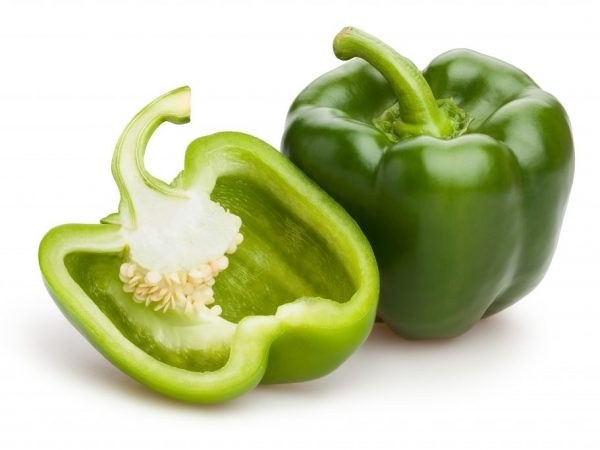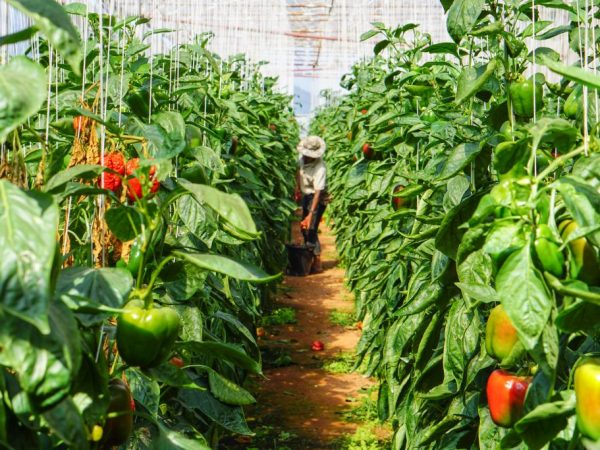Characteristics of bell peppers
A large number of varieties of this culture have already been bred. Their differences lie not only in colors, taste, but also in shape. Among the bitter varieties, Bell Pepper deserves special attention. The flower-shaped fruit is its unique characteristic.

Bell pepper
Characteristics of the variety
Bell pepper is a perennial crop.
- During the period of active growth, it reaches a height of two meters. Its terrestrial part is strongly branched. The shape of the leaves resembles spicy paprika leaves. The leaves of this variety and its stem are covered with a small fluff.
- The fruits are located separately from each other. Each ripe vegetable weighs 50 grams. Individual copies weigh 100 grams. Pepper variety Red Bell is classified as late-ripening. From the moment of the first shoots to full ripening of the fetus, 4 months pass.
- The crop is characterized by high yields. Each of her bush gives two kilograms of harvest. During the ripening period, the fruits change color from dark green to bright red. You can shoot a vegetable both yellow and green. The brightness of the burning or sweet notes of paprika depends on this.
- Variety Krasny Kolokolchik is suitable for growing in greenhouse conditions, outdoors, in pots for indoor ornamental plants.
The taste of the bell allows you to use it for preparing vegetable salads and slices. Canned vegetables do not lose their flavor characteristics.
Features of the fruit
Bell peppers belong to the group of berry peppers. His homeland is South America. The gardeners of our region learned about this amazing vegetable relatively recently. But he gained popularity instantly, and they began to grow it everywhere.
In addition to its unique shape, the Bell Pepper strikes with exotic taste. In a special way, it combines a pungent note of spicy varieties and shades of sweet and sour Bulgarian paprika. The part of the Red Bellflower near the stalk tastes like a savory bitter. The bottom of the fetus has thickened walls. The pulp from this part of the fruit does not differ from the fleshy sweet juicy pulp of yellow pepper.
Landing
Cultivation of bell peppers in our region does not differ from the cultivation conditions of other varieties of bell peppers.
Seed preparation
It is better to grow this variety from seeds of five years of age. Fresh seeds do not have all the properties of the mother plant.
Before sowing, the seed should be treated with a pink 1% manganese solution. Soak the seeds in the liquid for 15 minutes, stirring constantly. Then catch them and dry them.

Seeds can be germinated on their own
Germination
Paprika seeds germinate rather poorly. It is recommended to germinate the seed for good results. Put gauze or a piece of cloth folded in several layers in a low container. Put the prepared seeds on it.
Next, carefully pour in the liquid. For this, ordinary settled water at room temperature is suitable. Gardeners recommend using an ash solution prepared from one tablespoon of wood ash and one liter of water.
The liquid should moisten the gauze or cloth well. Prevent the seeds from floating in the water.
Place the container with the prepared material in a room where the temperature is maintained from 25 to 30 ° C, and cover the seeds with a transparent film. This will help provide the seeds with the air they need to breathe.
The first signs of germination appear after five days. Most of the seeds will hatch after two weeks.
Capacity
Sow paprika from the end of January. The normal development period for a crop from seed sowing to harvest is five months.
Sow seeds in prepared containers. These can be plastic cups. The culture of this variety does not like transplants. Therefore, take care in advance so that you do not have to disturb the seedlings with unnecessary processes.
Make holes in the bottom of the prepared cups to drain excess liquid.
Priming
The culture loves organically fertilized soils. Red Bell pepper will respond gratefully to the addition of good compost or rotted manure to the soil, as well as wood ash.
When preparing the soil, use dolomite flour, it will reduce the natural acidity of the soil. Add it to the soil mixture at the rate of 150 gr. flour for every bucket of earth.
It would be useful to add a complex fertilizer, which will saturate the soil with other minerals. Its rate is in the range from 50 to 70 grams per bucket of soil.
Mix the resulting mixture thoroughly, rub all the lumps with your hands.
Sowing seeds
Fill the prepared containers with soil mixture for a third. The seeding depth is 5 mm. If planting seeds in a large box, then observe a distance between rows of 4 cm. The seeds are laid out in grooves with an interval of 1 cm. If possible, make the distance between the seeds larger.
It is recommended to cover the seeds with a mixture of soil and sand in a ratio of 1 to 1. This will lighten the soil from above, nothing will interfere with the germination of the sprouts.
We cover the container with cling film and place it in a room where the temperature does not drop below 25 ° C.
First shoots
After the first shoots appear, remove the film and transfer them to a place with good illumination. Before planting in a permanent place of growth, provide the seedlings with twelve hours of daylight. If there is not enough natural light, additionally install special lamps.
The plant feels comfortable at temperatures from 20 to 25 ° C during the daytime and from 18 to 20 ° C at night.
Carry out the first feeding after the emergence of two true leaves on the seedlings. To do this, mix urea, superphosphate and potassium salt in a 1: 4: 1 ratio. Then dissolve it in 10 liters of water. Pour the seedlings with the prepared solution.
Landing on the beds

We plant seedlings
Start planting mature seedlings in a permanent place when the soil warms up, frost will no longer be a threat. You need to grow paprika in an area protected from the wind and well lit.
Gardeners recommend planting healthy seedlings in the evening, when the sun does not have such an effect on the plant. Break the paprika wells at a distance of half a meter. Place a handful of ash on the bottom of the holes. Immediately after transplanting, water the culture with a pink solution prepared at the rate of 1 gram of manganese per 1 liter of water.
Care
Bell Pepper needs the following procedures:
- correct irrigation regime;
- providing the plant with warmth and light;
- timely pest control;
- regular fertilization;
- the formation of bushes.
Spicy pepper does not like frequent and abundant watering. Water the plant at sunset. Defend the water beforehand. Do not pour cold water on the pepper.
The bell is very fond of warmth and light. In order not to expose the culture to hypothermia, use film shelters in the beds with spicy pepper.
Avoid overheating the bushes on hot summer days. To do this, construct a shade canopy and remember to ventilate the greenhouses.
Hot peppers do not like dense soils, so do not neglect weeding and loosening the soil in the beds.
Bitter Pepper Red Bell is loved by aphids, slugs, ticks. In the fight against pests, use folk methods and insecticides. The spicy variety is susceptible to fusarium diseases, mosaic disease, late blight. Use special fungicides to treat the plant. Do not neglect preventive measures in the fight against insects and pepper diseases.
Top dressing
The first feeding of hot pepper should be carried out two weeks after the seedlings are planted in a permanent place. For such feeding, use slurry diluted with clean water in a ratio of 1:10.
The next time, fertilize during the flowering period of the crop. At this time, use ash solutions and infusions. Prepare a classic solution at the rate of 150 grams of ash per bucket of water. Water the bushes with this composition, spending 0.5 liters for each plant.
Carry out the last feeding after three weeks. Use minerals this time. Give preference to potassium and phosphorus. The use of complex fertilizers is allowed. Use in the dosages indicated by the manufacturers.
Formation of bushes
Pay great attention to the formation of pepper bushes. Start working with the plant two to three months after the first shoots appear. After the 10th leaf, the stem of the Bellflower bifurcates. Further, each of them will also begin to bifurcate. Examine the plant during this period. Small branches have appeared on the bushes, which grow in the opposite direction from the main stems. Feel free to remove these processes.
They help thicken the middle of the bush.
Conclusion
The description of the variety shows that Bell Pepper can be grown in our region with proper care. The bushes of this culture can be a wonderful decoration for a personal plot.


